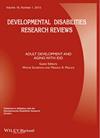Gregory S. Liptak, Ahmad El Samra
{"title":"Optimizing health care for children with spina bifida","authors":"Gregory S. Liptak, Ahmad El Samra","doi":"10.1002/ddrr.91","DOIUrl":null,"url":null,"abstract":"<p>The health care needs of children with spina bifida are complex. They need specialists, generalists, and an integrated system to deliver this complex care and to align and inform all the providers. Most research in spina bifida has been focused on narrow medical outcomes; it has been noncollaborative, based on small samples of convenience, with no comparison groups, and without consistent standards of measurement. Models of health, like the World Health Organization International Classification of Functioning, Disability, and Health Model can help to broaden the scope of future research. Using methods from other pediatric conditions like the patient registry (cystic fibrosis), gene bank (autism), and collaborative research (leukemia), researchers can improve the quality of future studies. Research questions related to the process of care and to specific nonsurgical conditions associated with spina bifida are reviewed in this article. © 2010 Wiley-Liss, Inc. Dev Disabil Res Rev 2010;16:66–75.</p>","PeriodicalId":55176,"journal":{"name":"Developmental Disabilities Research Reviews","volume":"16 1","pages":"66-75"},"PeriodicalIF":0.0000,"publicationDate":"2010-04-20","publicationTypes":"Journal Article","fieldsOfStudy":null,"isOpenAccess":false,"openAccessPdf":"https://sci-hub-pdf.com/10.1002/ddrr.91","citationCount":"60","resultStr":null,"platform":"Semanticscholar","paperid":null,"PeriodicalName":"Developmental Disabilities Research Reviews","FirstCategoryId":"1085","ListUrlMain":"https://onlinelibrary.wiley.com/doi/10.1002/ddrr.91","RegionNum":0,"RegionCategory":null,"ArticlePicture":[],"TitleCN":null,"AbstractTextCN":null,"PMCID":null,"EPubDate":"","PubModel":"","JCR":"","JCRName":"","Score":null,"Total":0}
引用次数: 60
Abstract
The health care needs of children with spina bifida are complex. They need specialists, generalists, and an integrated system to deliver this complex care and to align and inform all the providers. Most research in spina bifida has been focused on narrow medical outcomes; it has been noncollaborative, based on small samples of convenience, with no comparison groups, and without consistent standards of measurement. Models of health, like the World Health Organization International Classification of Functioning, Disability, and Health Model can help to broaden the scope of future research. Using methods from other pediatric conditions like the patient registry (cystic fibrosis), gene bank (autism), and collaborative research (leukemia), researchers can improve the quality of future studies. Research questions related to the process of care and to specific nonsurgical conditions associated with spina bifida are reviewed in this article. © 2010 Wiley-Liss, Inc. Dev Disabil Res Rev 2010;16:66–75.
优化脊柱裂患儿的医疗保健
脊柱裂儿童的保健需求是复杂的。他们需要专家、多面手和一个综合系统来提供这种复杂的护理,并使所有提供者保持一致和知情。大多数关于脊柱裂的研究都集中在狭窄的医学结果上;它是非合作的,基于方便的小样本,没有比较组,没有一致的测量标准。健康模型,如世界卫生组织的国际功能、残疾和健康分类模型,可以帮助扩大未来研究的范围。利用其他儿科疾病的方法,如患者登记(囊性纤维化)、基因库(自闭症)和合作研究(白血病),研究人员可以提高未来研究的质量。本文回顾了与脊柱裂相关的护理过程和特定非手术条件的研究问题。©2010 Wiley-Liss, IncDev disability Res 2010; 16:66-75。
本文章由计算机程序翻译,如有差异,请以英文原文为准。

 求助内容:
求助内容: 应助结果提醒方式:
应助结果提醒方式:


